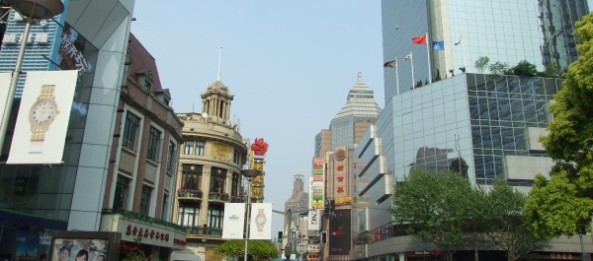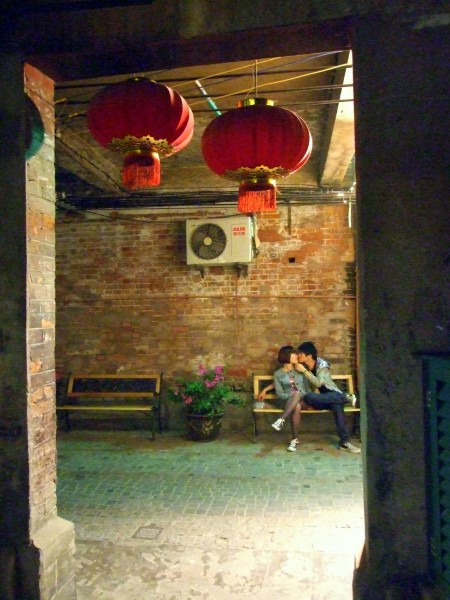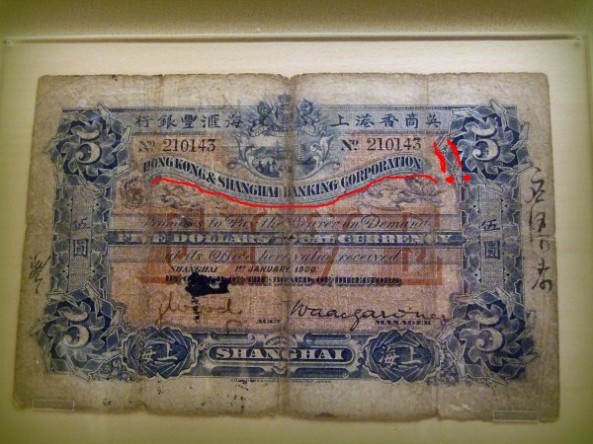Shanghai is like nothing else I’ve seen in China!
It is a different world where tradition mingles with modernity, where one corner smells of salt, sea and fish and another bears the odour of the most sophisticated and expensive fragrances one has ever felt. It is a place where romance may arise anywhere, a place where the clatter of money echoes from the steel and glass skyscrapers, it is a place where East and West have harmoniously been shaking hands for over a century.
Maybe Beijing through its jazzy palaces and monuments stands for a glorious past but Shanghai through its posh malls, restaurants and sophisticated buildings stands for the future. A future which seems full of brightness and splendor.
Signs of a communist past remain here and there but overall this veritably megalopolis which hosts over 23 million souls is rather similar to New York than to Beijing.
It is a city in continuous transformation and cosmopolitan. A city which keeps up with rapid economic, social and cultural trends. Ten years ago there were only 10 skyscrapers, today the skyline numbers over 100 and the number is growing fast.
What mostly fascinated me in Shanghai is the harmonious blend between past and present, between tradition and modernity, between pagodas, temples and water canals on one hand and magnificent skyscrapers, malls and clubs on the other. Although so modern and alternative, packed with tourist or business foreigners, this megalopolis induced me a sense of calm and relaxation, perhaps due to Asian culture and lifestyle. Compared to hectic and sleepless London, Shanghai seems more peaceful and friendly, although its economic development and expansion rhythm surpasses that of the British capital.
I was lucky to be hosted by locals in Shanghai which proved an extremely interesting experience and I received a lot of inside advice and help with the language barrier. This meant that in many cases they have done the talks and bargaining in the bazaars, asked for directions and even wrote me detailed notes in Chinese to show to taxi and bus drivers!
Both my hosts were true-born Chinese but like most of their fellows they too used Western names: Johnny and Fiona. This is common practice for when they meet foreigners or go abroad because Chinese consider their real names are too difficult to pronounce. Sometimes even a small sound said differently can turn a name into something else!
So, helped by my Chinese friends I have discovered some slices of traditional Shanghai: Lonhua Temple, YuYuan Garden and Bazaar, the flower, bird and insect market, Qibao – the water neighbourhood and the fabric market Shiliupu where clothes can be tailored made in one to three days.
- Lonhua Temple – although there are several Buddhist and Confucian temples in the city, Lonhua is the largest and the most authentic one, dating back to the Song dynasty. The entry fee is next to nothing and the interior and gardens are absolutely fascinating. A feeling of authenticity and holiness welcomes you once you step inside this sacred realm. Heady oriental fragrances mingle with the ding-dong chanting of priests who, day by day, bring about the same holy rituals and have been doing them for hundreds of years.
- The flower, bird and insect market is a bit… unusual, I must admit. It proved extremely helpful to go here with Johnny. He saw me staring at those hundreds of types of beetles, crickets and other bugs and explained that crickets can be bought as pets and this market is very popular with both children and adults. Johnny himself had one in the past but considered it a bit too noisy. A bit?! I personally consider crickets could make good pets just for deaf people or maybe they become depressed by being in a cage and after a while stop “singing”. Anyway, beetles there are destined to a tougher but potentially greater fate: they are bought for… betting. I grew to understand that beetle fights and bets are extremely popular with Chinese (a bit like ugly dog fights in England) and that generally speaking all living creatures in that market would make good pets, from crickets to fish, birds, snakes, dogs, mice, rabbits, squirrels – almost anything is acceptable as pet.
- Qibao – the neighbourhood on water is like a travel in time and space, a descent into rural China, of peddler markets, handicrafts, clay huts and singing beggars. Although it is in the suburbs, there are good subway links and I would recommend this place for its rural traits, for its picturesque alleys and houses, cheap and tantalizing foods and also for shopping (both for clothes or souvenirs).
- Yuyuan is a typical Chinese garden and every stone and tree are full of symbolism. It is worth visiting it with a knowledgeable guide who can uncover all the hidden stories and beliefs to you and all the unseen details and architectonic rules, known only by the architects from the past. Yuyuan Bazaar with its busy alleys, full of restaurants, stalls, shops and food bars for all tastes and pockets is less crowded in the evening. Besides, at night, Jiuqu bridge and the pool create a truly magical atmosphere. Don’t miss the famous Hu Xin Tin tea house for some romantic moments.
- Shiliupu is a paradise for cheap silk (for example I bought an evening dress for as little as Y150, the equivalent of £15), cashmere, wool and other textiles and the great news is they can be tailor-made. The building looks like a big deposit or factory – so give it a couple of hours to find what you’re looking for and make sure you bargain with the sellers.
In stark contrast with traditional Shanghai there are spots like the Bund and Pudong neighborhood which best convey the modern city of big finance, skyscrapers, lights and fast.
- Nanjing Boulevard and Lujiazui area of Pudong (don’t miss a visit at the Super Brand Mall, the “Manhattan of the Orient” – ultra-modern but ultra expensive too) are a shopping heaven for Western products and famous brands, located in the most luxurious stores. It is also a heaven of undercover sellers of fake goods: from bags, shoes, clothes, watches to jewellery and art objects, China has thriving grey and black markets. Do not be surprised and rest patient if you are being approached by several such dodgy sellers with “Plada” bags and “Lolex” watches (many Chinese struggle to pronounce the letter “r”) and be aware then can be very insistent.
- The Bund is the Huanpu river quay and it’s a real gate between two worlds: on the northern side of the river there is the Bund with its string of restaurants, bars, hotels and other centenary buildings with art-deco designs; on the southern side Podong’s powerful buildings stand tall: the Oriental Pearl Tower, Jin Mao Tower, Shanghai Financial centre and others.
- The Oriental Pearl Tower is the most architectonically daring while the Financial Centre is the tallest one at 492 metres and 101 floors. Jin Mao is in between them for altitude but it has Cloud 9, Pudong coolest bar – if you’re staying at Grand Hyatt 2 floors below you might get a free drink (or otherwise pay £8 for a coffee, the same like the entrance to the viewing platform). I think the coffee might be the best option – the views are great at night but during the day the smog makes the scenery a bit foggy and unclear. Mind you, pollution and power go hand in hand here. These powerful and radiant giants, shamelessly stinging the sky, envisage the growing commercial and financial power of China and Shanghai, the city which already overtook Hong Kong in terms of economic development.
- But the buildings on the northern quay tell a different story and are considered part of the old Shanghai. They talk about the times of British, French and Dutch concessions, about bankers and cosmopolitans of the past, about hotels and clubs and their glittering parties but also about the terrible opium houses which enthralled countless Chinese one hundred and fifty years ago. However opium (called “foreign mud”) trade shaped Shanghai’s history and pulled its commercial rise. Today these buildings host banks, hotels, bars, cinemas or private residences. They are of a rare beauty and fast and are entirely worth a visit. Here are just a few:
- Peace Hotel was the most luxurious hotel of Asia at the beginning of last century
- Customs House (Bund no. 13) prouds itself with a bell and clock tower which are an imitation of London’s Big Ben
- Bank of China (no.23) – a massive hefty building – was meant to be the mightiest of the Bund
- The ex-HSBC headquarter (did you know that HSBC stands for Hong Kong and Shanghai Banking Corporation?) located at Bund no. 12 has an exquisite interior – shame no one is allowed to take pictures inside
- House of Roosevelt – a superb 1920 building, built for Jardine Matheson, a famous British trading company (best known for their opium business). Later on the house passed on to the American presidential family of Roosevelts and today it is a luxurious wine bar with terrace. It might be a bit pricey but I think it has the best view over the Bund and Pudong and offers top quality wines.
These are just a few faces of this chameleonic place, quickly expanding, dazzling and welcoming at the same time.











your best piece so far, in my humble opinion … made me think I should definitely visit Shanghai … one day 🙂 keep on writing articles like this one 🙂
Ha-Ha! thanks, I’ll keep that in mind:)
advokat beograd
If a brand new post becomes accessible or if perhaps any changes occur on your web site, I would adore to read more and acquiring out the way to make excellent usage of those approaches you discuss. advokat beograd
Pingback: Bitesized China | Globe Drifting
Pingback: Bitesized China | Globe Drifting
Shanghai is totally different from the rest of China, it’s like being in another country compared to Henan province, where I live. I really enjoyed Shanghai’s mix of old and new, and I definitely enjoyed the cleanliness!
Pingback: Bite-sized China | Globe Drifting